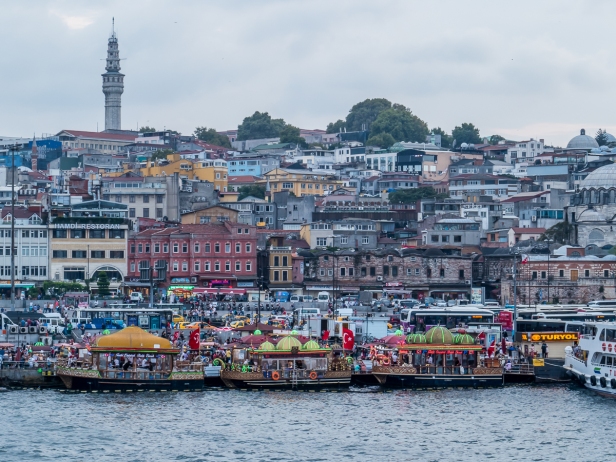
22-29 September 2015. Somewhere in Istanbul. We are far from the usual tourist haunts, walking down a narrow cobbled street. There is a group of men in the street ahead of us. As we reach them we can see they are standing outside a very large barn-like building with a dirt floor. It seems odd to find such a place in the middle of a big city. It has two enormous rolling doors, each big enough for a two-car garage. One of the doors is wide open. Inside, standing in the dirt, interspersed between the wooden support pillars topped with wooden beams and a high roof, there is livestock: maybe six or eight cows. Near the door I see with nauseating horror a cow tied to a post with its head wrapped with a bright yellow plastic bag to cover its eyes. It is the next to be slaughtered. The smell of a farmyard hangs in the air. And the smell of blood. And the smell of fear.
I know what it’s all about but hadn’t expected to be confronted with it in such an uncompromising way. It’s Kurban Bayrami. I ask, by holding up my camera, if I can take photos and am told sure, no problem. I’m about to take a few quick snaps when another man approaches and starts shouting Problem! Problem! He then rattles off a great tirade in Turkish from which I glean two words: Sultanahmet, and Ayasofya. Sultanahmet, the “Old Town”, is the main tourist area in the city. Ayasofya is the biggest tourist attraction. His meaning is clear – stay in the tourist areas. You are not welcome here. He then pulls the large sliding door closed.
We turn to leave and I notice that there are two white panel-vans on the opposite side of the street. They are parked back to back with only a few feet between them. Both have their back doors wide open. The doors meet and hide whatever is happening inside the vans. They are liberally splattered with blood.
It is Kurban Bayrami, the “holiday of sacrifice”, an annual Islamic holiday. It is like Christmas in only one respect: that Turkish families gather together. All forms of transportation are usually fully booked as people all over the country travel to be with friends and family. We had deliberately arranged our schedule to avoid being on the move during the five days of this holiday. Kurban Bayrami is also like Easter in that almost everyone has at least four days off from work, and in that it has deep religious significance. Apart from these similarities Kurban Bayrami is entirely itself. It is the most important Islamic religious festival in the year. It honours family, community, and charity.
Kurban Bayrami celebrates the Koranic story of Ibrahim’s willingness to sacrifice his son Ishmael as a sign of faithfulness and obedience to Allah. According to the story, at the last moment an angel stops Ibrahim and a lamb is sacrificed instead. Essentially the same story is told in the Bible about Abraham and his son Isaac.
To keep alive this message of obedience to Allah a tradition was born. Until not so long ago the head of each household would sacrifice a sheep or other animal, killing and butchering it in the street or in a garden. These days authorized abattoirs are located in fields at the edge of the city where trained butchers kill the animals in a sanitary manner, and cut and package the meat. There are also mobile slaughterhouses set up throughout the city. I suspect that the operation we happened upon was illegal, though possibly the two vans were a mobile slaughterhouse. We’re in the middle of a huge city; I do wonder where all those cows came from.
Friends and family are invited to a sumptuous feast, and the remaining meat, and the hide, is given to charity for the poor. Traditionally children are given new clothes and wear them throughout the days of the festival.
Earlier, we had begun our day by visiting Chora Church. It was a long tram ride with a change of lines part way through, and then a longish walk. Even after all these years of travelling we are absurdly pleased when we manage to successfully negotiate the transit system of a new city, especially one the size of Istanbul. After the tram rides, and before the walk to the church we stopped in at a nargile bar for a coffee.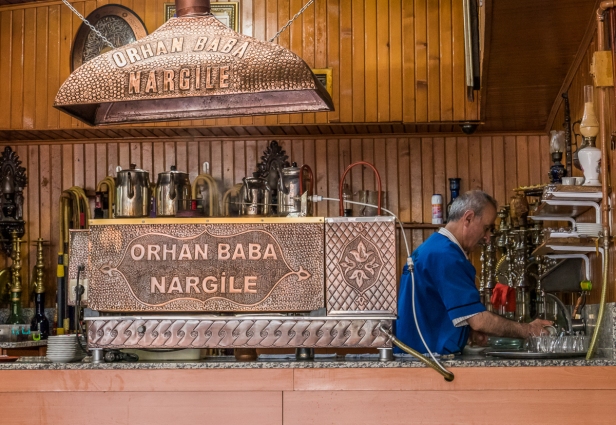
A nargile is a Turkish water pipe. They have been around for centuries and are used for smoking flavoured tobacco. Originating in India they became popular in Turkey and the near east in the 1700’s at the height of the Ottoman Empire. In those days smoking with the sultan was considered the ultimate honour: reclining on a couch, enjoying a relaxing and intimate ritual with the most important person in the world. A great accomplishment. Only the most trusted would be invited. And perhaps also the most useful, for surely careful and cunning politics would have been an ever-present motivator for the sultan. Whatever the sultan’s motivation, being invited to join in the ritual of smoking a pipe with him would have been a prestigious triumph.
The popularity of nargiles faded for a while but since the 1900’s there has been a revival. We frequently saw both men and women in nargile bars all over Turkey, Jordan, and Egypt relaxing with friends in a bar, socializing and enjoying a nargile, in much the same way we would go to a bar for a drink.
The Church of the Holy Saviour Outside the Walls, in Chora, is an ancient Byzantine Greek Orthodox church that is now preserved as a museum. The interior is covered in some of the oldest remaining Byzantine mosaics and frescoes dating from the fourteenth century, making them close to seven hundred years old. Although part of the church is closed for renovations it was worth the visit to see the gorgeous golden mosaics and soaring frescoes.
One little gem from the meanings behind the designs: in the narthex the mosaics describe Mary, the Mother of Jesus, as “the container for the uncontainable”.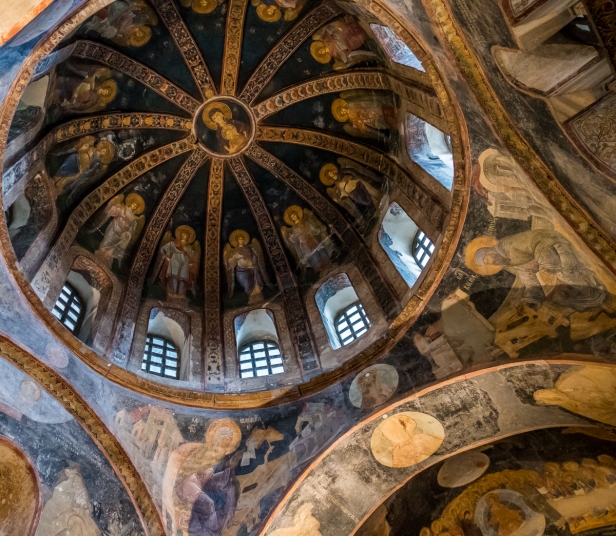

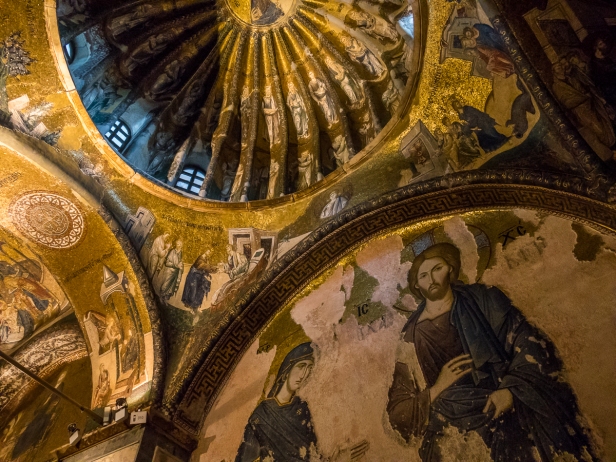

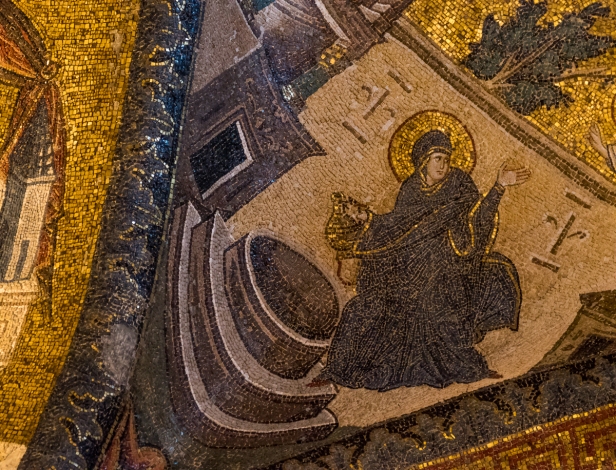
Wandering on from Chora Church we come across a courtyard filled with cats, maybe a dozen of them. This one has commandeered the best seat.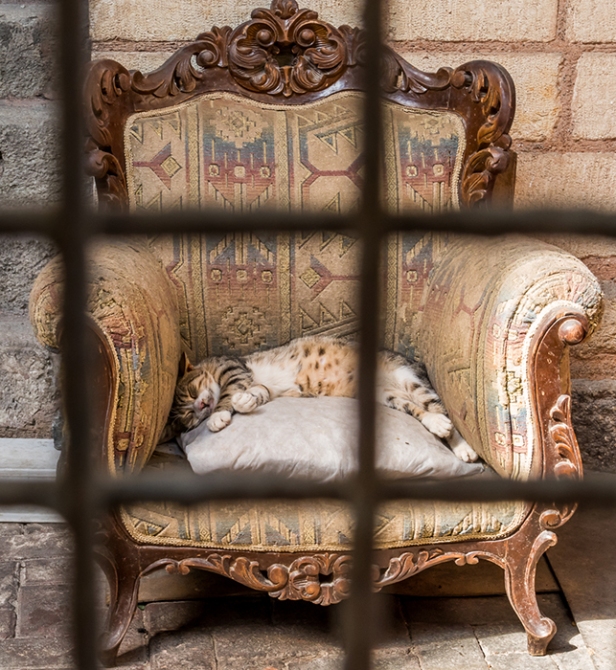
Then, with a take-out meal, we climb to the top of the old walls of the city and eat lunch up there with the view spread out before us.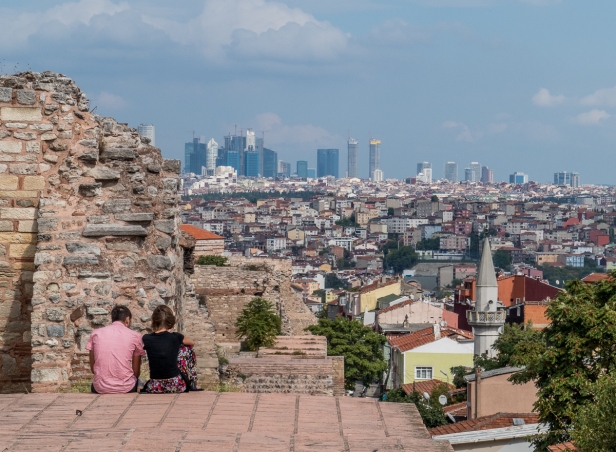
As we are walking along the top of the wall we see a family in their yard below having a feast. Next to them on the ground is a large pallet covered with freshly cut raw meat. The head of the animal lies on the ground nearby. They are celebrating Kurban Bayrami.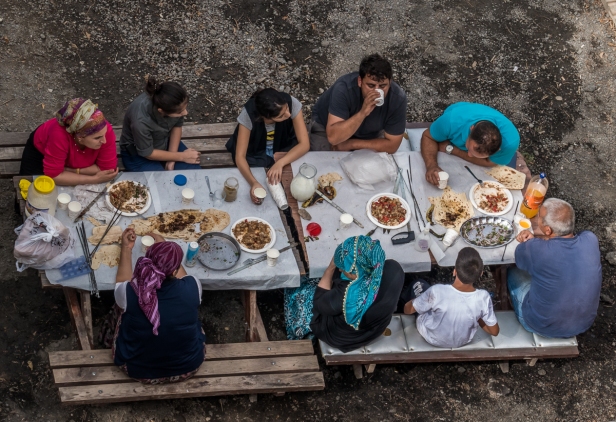

They see us and invite us to join them but we can’t figure out how to get down to them.
We climb down the stairs from the top of the wall, on the opposite side from the feasting family, and wander on down the narrow streets, unexpectedly coming across the possibly illegal slaughterhouse on the way. We are hoping to eventually find our way back to the waterfront.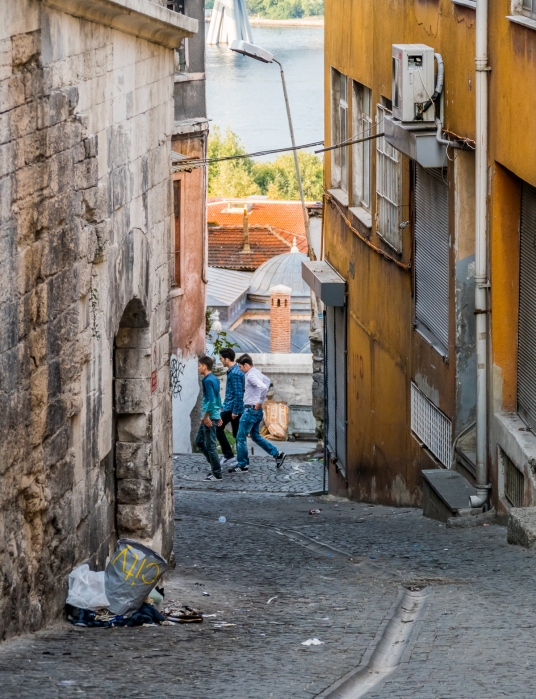

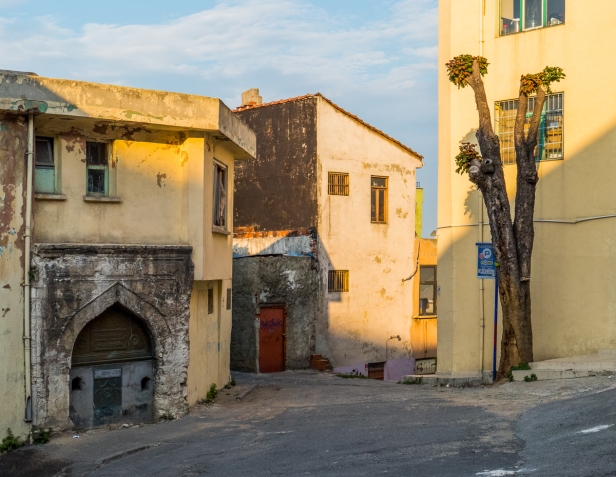
We come to some lanes near the spice market. The spice market is closed for the holiday, but some of the stores in the cobbled lanes nearby are open. A strong smell of spices hangs in the air, and like hawkers the world over, the merchants shout out their bargains.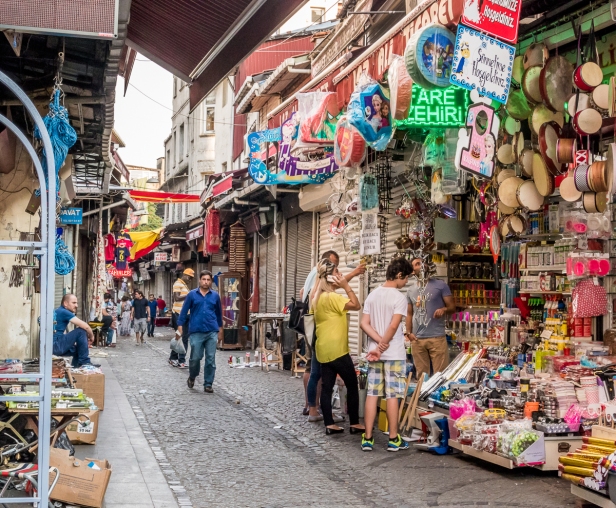
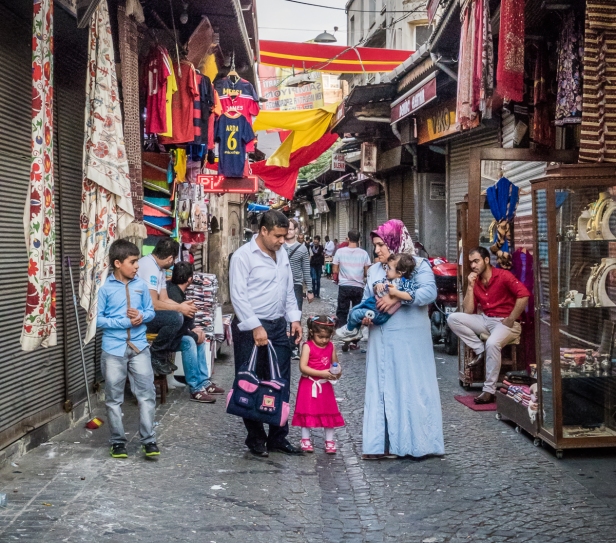
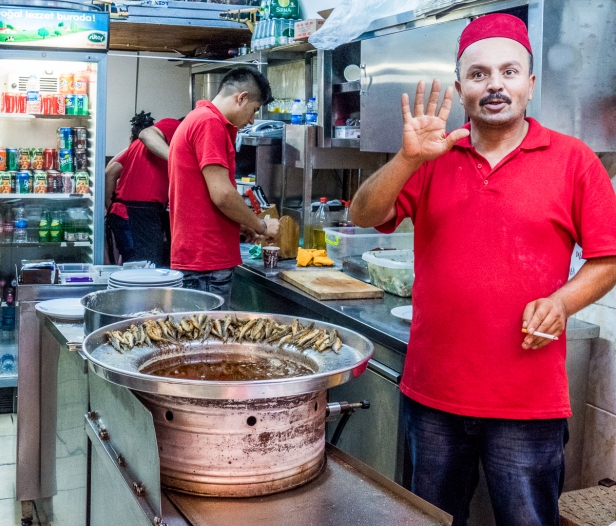
We make our way to Rüstem Pasha Mosque, close by the waterfront. It was built in the 1560’s for Rüstem Pasha, the Grand Vizier to Sultan Suleiman the Magnificent. The mosque is known for its exquisite blue Iznik tile work, and doesn’t disappoint.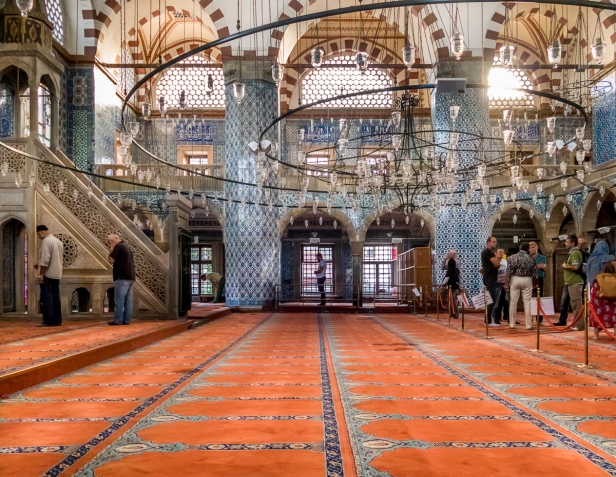


This is my favourite section of tile-work because of its free-form made-from-scraps patchwork nature, as if the artist suddenly broke free from restraint.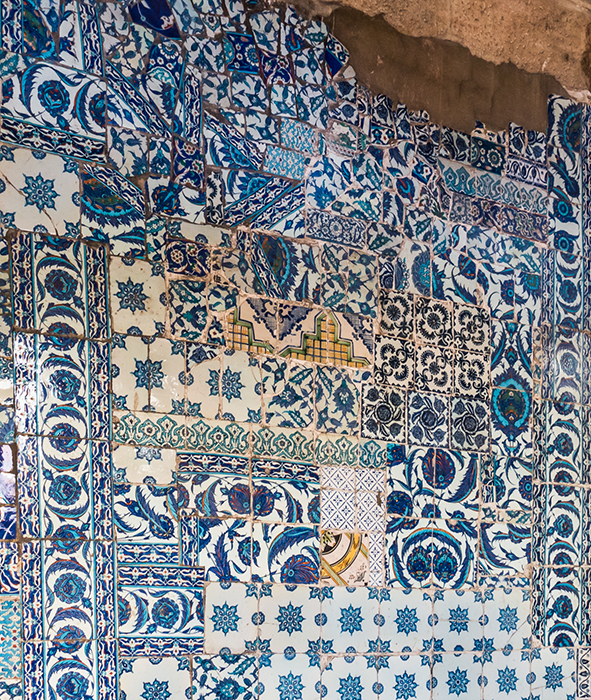
The exterior of Rüstem Pasha at night.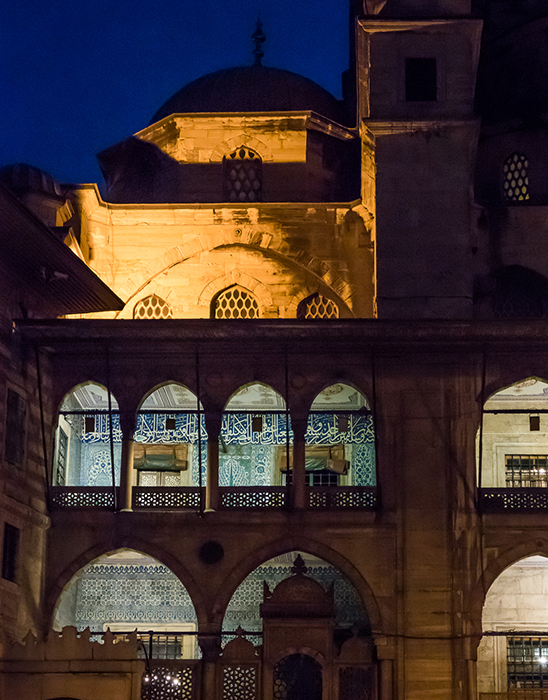
From the courtyard of Rüstem Pasha we can look down into this lane,
where people eat at a sidewalk restaurant.
We eat there too, a couple of times, sitting on little stools in the alley as people come and go around us. It’s typical eastern Mediterranean fare – salad, pita bread, and meat skewers or chicken.
Rüstem Pasha is close by the ever-busy waterfront at Eminönü. We are there on many different occasions. It’s the place where you catch the ferries – up the Golden Horn, or along the Bosphorus, or across it to the Asian side of Istanbul. We went to the Asian side one day and found out why no one bothers. It’s unremarkable.
From the waterfront you can wander over Galata Bridge, or hang out on the bridge at sunset and watch the fishermen. The lower deck of Galata Bridge is crowded with restaurants, and along the water there are floating restaurants with neon lights, serving Turkish-style fast food. And there’s a great open space to hang out and watch all the activity, especially during Kurban Bayrami when it’s crowded and everyone is on holiday. Day or night there is always something to see.
Like the ladies selling seeds to feed the pigeons, and the kids playing with them,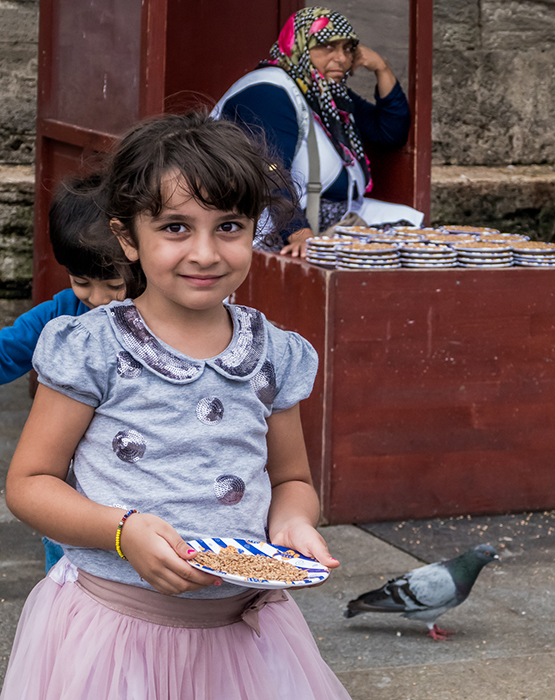
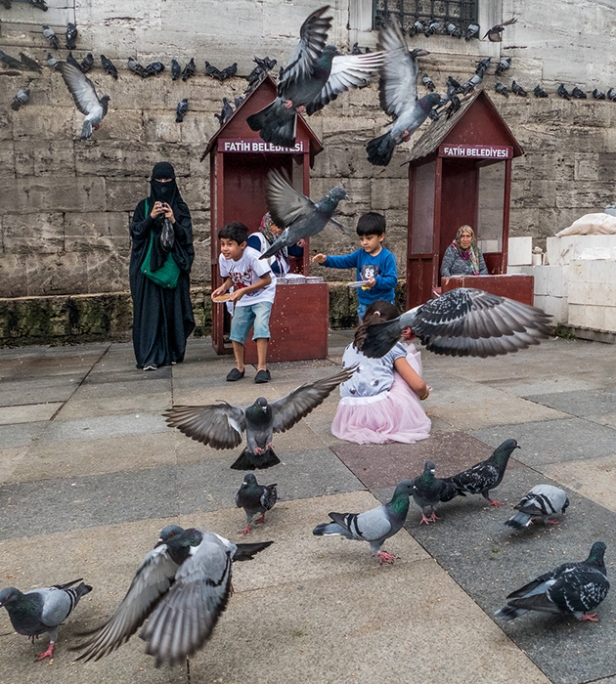
creating an explosion of birds.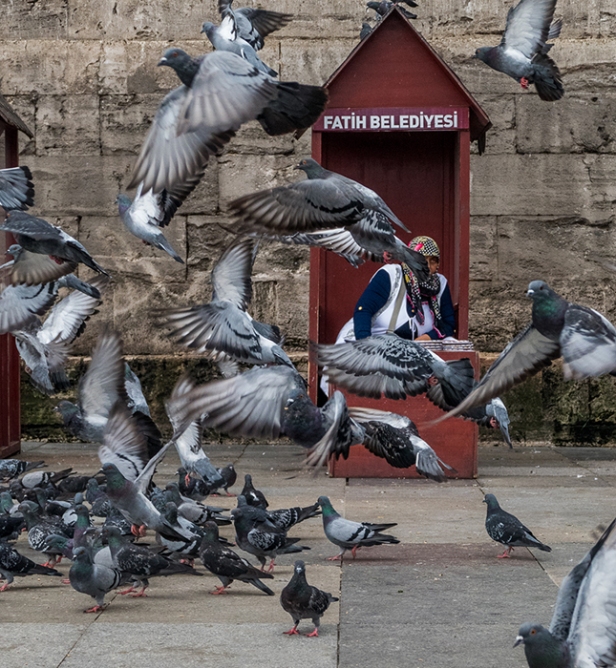
Like hawkers selling everything from prayer beads, to Turkish flags, to leeches.

Like this group, full of vacation camaraderie and a sense of freedom over the holiday weekend.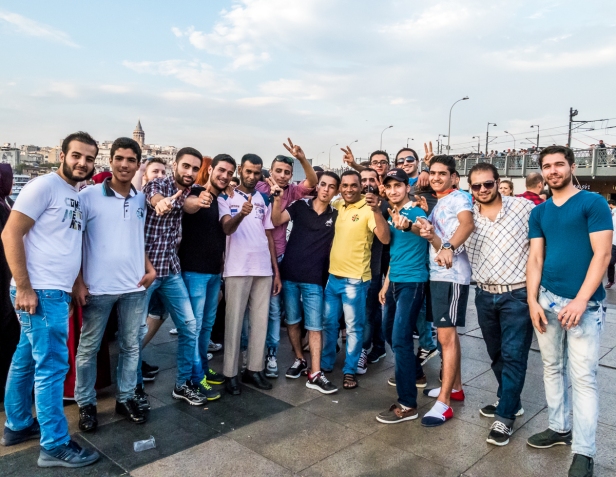
Like this unexpected grouping: a man, a woman, and a tourist.
Like these boys with their family waiting in the crowd for the ferry.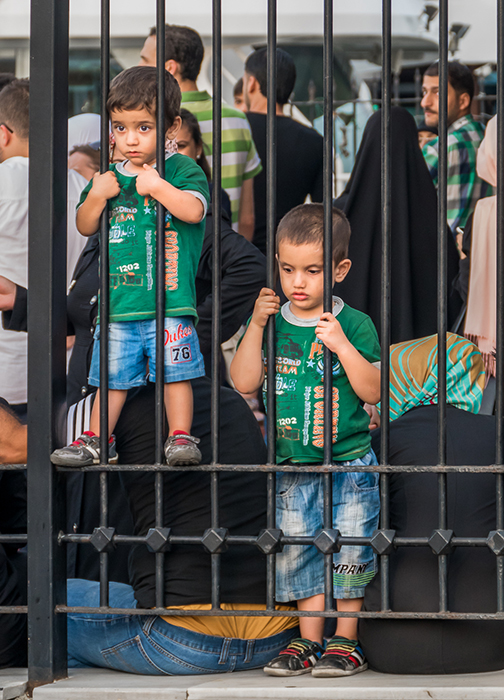
Like the newest little sultan,
and his sister. I was determined that he, with his fancy outfit, was not going to get all the attention so I turned my camera to her and was rewarded with shy surprise.
And at night – the hordes hanging out on a holiday weekend,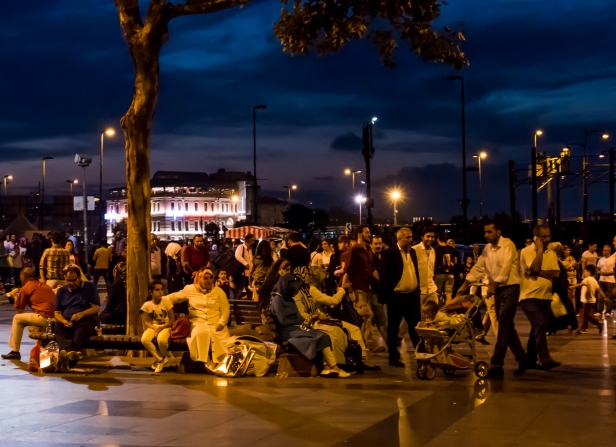
and a view of Galata Tower.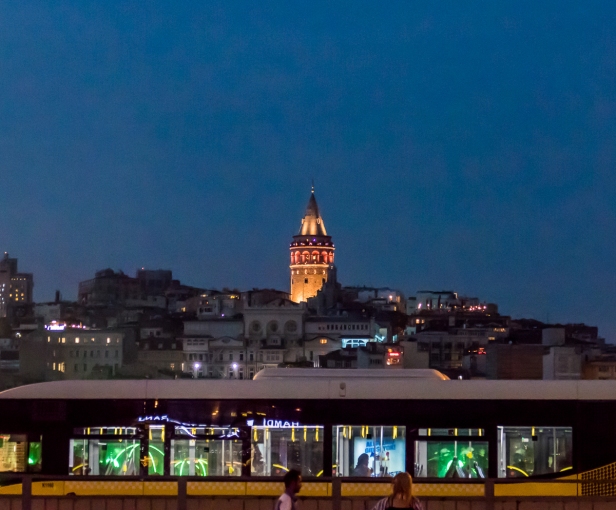
Next post: The incomparable (and not in a good way) Hagia Sofia, the spice market, and the truly grand Grand Bazaar.
All words and images by Alison Louise Armstrong unless otherwise noted
© Alison Louise Armstrong and Adventures in Wonderland – a pilgrimage of the heart, 2010-2016.

You make my feet itch to be on the move!
LikeLiked by 1 person
Thanks 🙂
Istanbul is definitely worth a visit – fascinating place.
Alison
LikeLiked by 1 person
I’ve never been particularly excited about slaughter houses. In Liberia, if you wanted local meat, you’d have to get to the market around 6:00 AM. The cow/steer would have been killed an hour or so earlier and be hanging from a post. You had to point out the piece you wanted and they would cut it off of the carcass. Meat without bone was ‘steak.’ Was on a river a couple of weeks back that warned swimmers that there were leeches in the water. No thanks. Your photo confirmed my decision. 🙂 –Curt
LikeLiked by 1 person
I’ve never had a leech on me and I hope I never do. My niece and her husband have a property in sub tropical Oz. They always wear boots and sox and bug spray, or rubber boots to walk around the property – to protect from leeches. We got back from a walk one day and sure enough Malcolm was removing leeches from his sox. Ewwwww.
I remember the meat “shops” from when I was in Africa – I didn’t eat any. Again ewwwwww.
Alison
LikeLike
Ewwwwwww ! says it all Alison. 🙂
LikeLiked by 1 person
Ugh. I would have converted to vegetarianism, right there.
LikeLiked by 1 person
Yeah, it was all pretty raw. Still I’d have stayed to watch if I’d been allowed to. It’s not like humans killing animals for food or for sacrifice is anything new. It’s kind of primal really. And I’d no doubt have still been upset by it.
Alison
LikeLike
I get it that humans are carnivores. Feasting with the animal head in view, however — just no.
LikeLiked by 1 person
Brings back terrific memories of Iatanbul last year! Ohhh those fresh grilled mackerels at the waterfront fish market… Yum. Looks like you guys had great time too. Very beautiful city.
LikeLiked by 1 person
We had a fabulous time in Istanbul. It really is one of the world’s great cities.
Alison
LikeLike
Fabulous reporting – i could almost smell it
LikeLiked by 1 person
Thanks so much Jo Ann. It was a mildly harrowing experience but I was so full of curiosity I do wish I could have stayed to watch. And or joined the family who invited us.
Alison
LikeLike
A photographer’s paradise! Great article on this fascinating city. I could go there a dozen times and still not get tired of it.
LikeLiked by 1 person
Thanks Helga. I too could go back to Istanbul, an amazing city, full of fascinating nooks and crannies. And yes, a photographers paradise.
Alison
LikeLike
It all looks interesting but the tiles are just so gorgeous!
LikeLiked by 1 person
It was pretty fascinating – a huge cosmopolitan city buzzing with life. I *loved* the tiles – so beautiful. I first saw Iznik tiles in the Metropolitan Museum of Art in NY about 20 years ago and fell in love with their beauty on the spot. Turkey was the first place I saw them in situ.
Alison
LikeLiked by 1 person
I loved Chora Church, and the mosaics were indeed very beautiful. There was one cat inside the church and it jumped into my lap, another reason why Istanbul is one of my favorite cities. One day I spent the afternoon at the Asian side of the city, but I stayed at the promenade along the waterfront where you can see Maiden’s Tower. I did wonder, though, how nice it would be to explore the neighborhood. But you convinced me to rather explore other parts of the city if I do come again one day.
LikeLiked by 1 person
We only went to the Asian side for a day too, and explored the neighbourhood away from the water. It was interesting enough I suppose, but nothing compared to all there is to do and see on the European side. We also loved Chora Church – such beautiful mosaics and frescoes. It was worth seeing even though half of it was closed for renovations.
Alison
LikeLike
What an amazing account! Felt like I was there with you… Animal sacrifice in the name of God is a little screwed up… I’ve always felt so! If the spirit of Abraham or Ibrahim is what they’d like to keep alive, they should probably find a less bloody way of doing it…
LikeLiked by 1 person
Thanks Aishwarya. Lovely to have you along 🙂
Animal sacrifice is as old a humanity I think. At least there used to be some kind of sacred ritual and thanksgiving to it, rather that the mindless slaughter that happens today, so for that reason perhaps Kurban Bayrami has something going for it, though I question how much sacred ritual was actually happening. At the same time I do agree there no doubt could be a less bloody way to honour God.
Alison
LikeLiked by 1 person
Great post, Alison. You described the stories clearly. It made me want to come back to the city again…
LikeLiked by 1 person
Thanks Nurul. Istanbul’s a fascinating city, so much to see and do, so much life!
Alison
LikeLike
The amazing experiences just keep coming Alison. I wonder at all that raw meat, did you see many flies around? The beautiful blue tiles are stunning, then all of a sudden they go out of sequence, quite strange… And as always you capture the spirit of the people.
LikeLiked by 1 person
Thanks pommepal. I think all the amazing experiences come because we’re nosy 🙂
We didn’t see flies, but then we weren’t ever very close to the raw meat.
I think where the tiles go out of sequence was a repair job done at a much later date and all they had was scraps, but it’s still my favourite part.
Alison
LikeLiked by 1 person
Whoa…that first photo is so dazzlingly colorful. But the first paragraph is so hauntingly beautiful and at the same time, so hauntingly horrible…in one way. I’m wondering if the blue tiles that went awry was an attempt at some point to simply “repair” that area, as it does look like it was repaired, or not finished. It is so unlike Islamic art to go berzerk with their designs…in a berzerk manner as opposed to their controlled berzerk designs. The waterpipe photo is very cool. For some reason, I’m glad you showed no photos of heads of cows.
LikeLiked by 1 person
Thanks BF. We were both fascinated and appalled when we came upon the slaughterhouse. I would have no doubt been horrified, but still I’d have liked to have been able to stay and watch. I’m immensely curious. I do think the section of “wayward” tiles is a repair job for sure. Maybe done decades after it was built and all they had left was broken bits. It’s still my favourite part.
The head of the cow is included in the picture of the pallet of raw meat 🙂
Alison
LikeLiked by 1 person
Of course I went back and looked at it! Curiosity trumps revulsion.
LikeLiked by 1 person
🙂
LikeLike
Cow head…oh, lord…that brown thing off to the side? At least it’s not all bloody and gory, thank you.
LikeLiked by 1 person
🙂
LikeLike
I had bloodsuckers on my in a lake as a child, it was truly icky.
The picture of the family with all the raw meat on the blanket struck me rather oddly, given that pets are taboo and seen as ‘dirty’ in at least some Islamic societies – something I find very sad, and think does nothing to support humanity in a society (will avoid that rant for now).
So, for dead chunks of meat and a cow’s head to be left out, outside in a hot summer climate seems odd, as it is certainly not the cleanest practice.
LikeLiked by 1 person
I’ve never had a blood sucker on me and I hope I never do. Ewwwww!
I never got the idea that pets are taboo on Turkey. I’m not sure how long that family would have left the meat lying outside like that. As for leaving the head of the animal lying on the ground, I’m not sure I could have sat down to eat there. I’m not sure I could have eaten any of that meat at all if I’d seen the animal killed right in front of me. I’m fairly sure that killing and butchering an animal there in their yard would have been illegal.
Alison
LikeLike
smell the fear…that’s a lingering thought…for me it matters knowing where my foods come from and what I choose in the un/ethical treatment involved of all the our ways are created for consumption…what foods we eat and create has become highly political…I’m always conflicted as I work or travel as outsider…always thought provoking Alison thank your for your share ☺️
LikeLiked by 1 person
Thanks Hedy. It was eye opening for us. I knew Kurban Bayrami would be on, and knew it involved animal slaughter for meat (as opposed to for trophies), but certainly didn’t expect to run into it in such a glaring manner. I’m also conflicted, and hypocritical. When I can I eat organic meats, and animals that have been kindly raised, but travelling it’s frequently not possible, and I want the protein so I eat what’s available. Food wise I like most to be in Vancouver for the choices available for ethical food.
Alison
LikeLike
Wow, thank you for taking us on a journey through the less touristy side of Istanbul. The many faces this city has to offer keeps me fascinated. 😉
LikeLiked by 1 person
Thanks Ana. Istanbul was endlessly fascinating. It really is one of the world’s great cities. There’s a lot to see and do there.
Alison
LikeLiked by 1 person
Funny that we both did killing-animals-to-eat stories this week … only yours is much more extreme! As Badfish said, I am grateful that you did not show us any severed animal heads or much beyond the huge pile of cut-up meat. I watched a Maasai ritual in which they killed a goat, and the animal’s fear was the part that affected me most. Blood I can deal with; heart-wrenching fear does me in. But to move on … what a nice ramble this was with you through the city. I remember being the only visitor at Rüstem Pasha Mosque one day and so enjoying its peacefulness. Thanks for the great explanation of the holiday also!
LikeLiked by 1 person
I was pretty horrified by your story! At least I didn’t have to eat any of the meat laying around, and hadn’t befriended the animal. The animal’s fear is palpable and heart-wrenching. But I’m a hypocrite – I still eat meat, as long as I don’t have to watch it being killed. It was a lovely ramble that day, though I’ve conflated a couple of different rambles. That day we actually went to Suleimaniye Mosque which I covered in the previous post. It all seems to run together in the end anyway, and if I hadn’t kept a daily journal I’d not have even known which pictures belonged to which mosque, but the tiles of Rustem Pasha stand out in my memory, and the leaning over the edge of the courtyard to look into the busy alley below.
Alison
LikeLiked by 1 person
Glad to know that pets aren’t taboo in Turkey, Alison, though I didn’t think they were. I know they are in Saudi Arabia. As I understand, it is okay to touch an animal but need to wash afterwards, and Saudis don’t have pets. I think the same would the case in several other fundamentalist or fundamentalist-inclined Islamic societies.
LikeLiked by 1 person
I’d never heard of that before – pets and Islam and them being taboo in Saudi.
A.
LikeLike
I am grateful to see through your eyes, Alison. You are my favorite travel writer. I alway feel intrigued and drawn in. Your photographs here blow me away, and I enjoy,very much, your consistently unique shots of dining experiences. This, in my mind, is your specialty!
LikeLiked by 1 person
P.S. Reminds me a little bit of my time in S. Africa at the townships. I photographed the severed steer heads and accompanied flies – at the time, I was horrified. Maybe I would still be now? I don’t know. I honestly don’t know. I’m definitely not into death, but I am a lot less surprised by lifestyles.
Wow! Yeah, no… There’s still lots of horror in the cycle of killing animals – and seeing the dead laid out in rows, all red and fiercely fresh. I’m sorry. I love you. Please Forgive me. Thank you. Ho’opono’pono
LikeLiked by 1 person
I love the Ho’opono’pono way of looking at it. I think I’d be upset, but still fascinated. Despite the years of travelling and experiencing many different lifestyles I think I’m actually more sensitive now than I was when I was younger – I feel the animal’s fear and pain so I find it hard to take. Don and I went to bullfight in Peru and we both had to leave as soon as they started sticking the pics into the bull’s back. We couldn’t bear watching the cruelty.
Alison
LikeLiked by 1 person
Thank you so much Ka. Your favourite travel writer! Wow! What a huge compliment. Thank you. I don’t that often post about what Don and I eat (though I do sometimes) but I love to photograph others dining – people are at their most natural.
Alison
LikeLiked by 1 person
I loved the “wayward” tiles, too. Very holy, truly. Like a glimpse of a higher order or something. And I loved the explosion of birds. Like a flood of life, rising. It balances out the meat falling down in piles in this post… 🙂
The cat in the chair… so beautiful. The container of the uncontainable, I loved that. I feels as I’ve been on a tour of real life, and found it to be even more than I could have imagined. Thank you! Lovely as always!
Much Love
Michael
LikeLiked by 1 person
Thank you Michael. The wayward tiles are for me an expression of freedom, and joy, so yes, holy. And watching the birds was more joy – a playful expression of life. I hadn’t thought about it balancing the fallen meat, but what a nice way to look at it. Holy.
I too loved the recognition of Mary as the container for the uncontainable – a sweet example of the mysticism that’s found in all religions.
Real life is always more than we could have imagined when we just stop to look. I’m doing more of that lately.
Alison ❤
LikeLiked by 1 person
Hi there, I read your new stuff regularly. Your story-telling style is awesome, keep doing
what you’re doing!
LikeLike
Thanks so much Marty. I’m glad you’re enjoying the blog.
Alison
LikeLike
It’s fascinating to see “the old” mixed with “the new”, different cultures in once place, different generations of the same culture.. Amazing post Alison, as always:)
LikeLiked by 1 person
Thanks so much Christie. I loved Istanbul for the mix – of cultures, of generations, of neighbourhoods, of traditions. It was endlessly fascinating.
Alison
LikeLiked by 1 person
As always, Alison, I love your stories and the photos that accompany them. Your photos of the leeches reminded me of the time we ordered and kept in our hospital pharmacy refrigerator for several days, medicinal leeches. These were attached to a patient’s almost severed ear to increase blood flow and promote the healing and reattachment. I was always happy to let one of the other pharmacist’s select one out of the mass with tongs to dispense to the doctor. Just a bit squeamish… 🙂 Anita
LikeLiked by 1 person
Thanks Anita. Oh leeches to help reattached ears. Oh. I don’t think I’d have been able to be a part of that. Just thinking about it makes me squee. Did it help?
Alison
LikeLike
Alison, that is possibly the most fascinating account of Istanbul I have ever read. You combine the grit and the beauty so very well. And what marvellous photos! My favourite from so many exotic snapshots? The fat cat on that beautiful chair 🙂 Truly, Istanbul remains one of my favourite places on earth, its politics notwithstanding.
LikeLiked by 1 person
Thanks so much Madhu. What a wonderful compliment. Isn’t that cat superb! I think I took a few shots of all the different cats in that courtyard – through the grill-work of the fence – and that was my favourite. Istanbul is one of my favourite cities too. I think it stands alongside the world’s great cities like New York, Paris, London and Rome. We loved it – the grit and the beauty both.
LikeLike
You do so much in one day!! I was raised on a ranch and saw the slaughter of animals which is why I am a vegetarian now. I would not have liked seeing the slaughterhouse (legal or not) The cat on the comfy chair is precious as are the blue tiles.
LikeLiked by 1 person
Alison, like Madhu, I have yet to read a description of Istanbul that is as balanced and thought-provoking. I was hoping you and Don would find a way to the family enjoying their Kurban Bayrami feast – if only there was a clearer route from the city walls!
Bama and I were in the Banda Islands at the time; there wasn’t much of a celebration because the festival is not a big deal in Indonesia. People get the day off work, dress up to worship at the mosque, and meat is distributed to the poor, but it doesn’t seem to get any bigger than that. The guesthouse owner said he would teach us the recipe for an Arab-inspired dish with meat from the sacrifice, but he never got any meat. No surprise there because he was probably the richest man in the islands.
Anyway, back to Istanbul. I know I would love Chora Church and the intricate tilework of Rüstem Pasha Mosque. The photo of the mangy cat looking sheepishly at the camera is a gem; it’s as though you caught him/her stealing the chunk of raw meat. As for that scholarly looking man smoking a nargile while on his laptop… it makes me wonder if you and Don did that while writing from Istanbul!
LikeLike
Thank you James for your wonderful compliment. Istanbul is an amazing city, with so much to offer, both in spectacular sights, and the cosmopolitan neighbourhoods and local traditions. I think it is one of the great cities of the world, and I was glad we got to spend so much time there.
Both Chora Church, and Rüstem Pasha are worth visiting to see the soaring beauty and intricate detail created from craftsmen of long ago.
Ha! That mangy cat was a surprise. I love the way it looked at me – don’t come near my meat! I think it maybe would have tried to attack me if I’d threatened to take it away. But yes, it does look guilty too!
No, we didn’t try the nargile pipes, though I thought about it. I was curious. Neither of us smoke, and I have spots on my lungs (though no problems with them) from smoking when I was young, so we weren’t about to try, but yes, you do occasionally find us with our laptops in local cafés.
Too bad you didn’t learn the recipe for that Arab-inspired dish.
Alison
LikeLiked by 1 person
What a wonderful account of Istanbul! So many different sides to a place, you truly got under it’s skin and revealed a new story. A cultural tidbit for you: the boy in the fancy feathered outfit? It’s a circumcision costume! From my understanding, circumcision in Turkey is a rite of passage that happens around 7 or 8. There’s a big party, and of course, tons of photos in the fancy costume. Where I live in Izmir, there’s a fabulous fashion market that sells over-the-top wedding dresses and circumcision costumes.
LikeLiked by 1 person
Thanks Mo. Istanbul is an amazing city – so much to see and do. I’m glad you liked this encounter with it. Thank you for telling me bout the circumcision outfit! Obviously I never knew that. Poor boys. I’ve seen the OTT belly dancing outfits, but not the bridal or circumcision outfits.
Alison
LikeLike